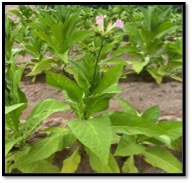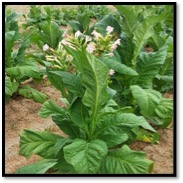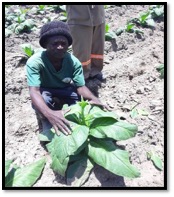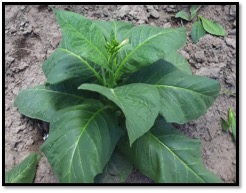|
Getting your Trinity Audio player ready…
|
By Tobacco Research Board
- Introduction
The Tobacco Research Board (TRB), has received several reports of pre-mature flowering and early flowering of tobacco crops this season (2022-23). Early flowering was observed at all stages of crop growth and across all varieties, in both the irrigated and rainfed tobacco crops. In the farm visits that ensued, it was established that this problem had been caused by a wide range of factors that differed from farm to farm.
The aim of this dear grower is to provide an outline of two separate scenarios that may cause the tobacco to flower sooner than usual and to provide farmers and the industry as a whole with management alternatives.
- What is premature and early flowering in tobacco?
Tobacco farmers occasionally report incidences of tobacco flowering immediately after transplanting or within four weeks after transplanting. Firstly, premature flowering (Fig 1a), occurs when tobacco plants begin to flower within 6 weeks after transplanting. The plants will develop irregular, strappy leaves that resemble sucker growth more than normal plant development. The second, and currently most described, scenario this year is early flowering (Fig 1b). This occurs when a plant produces normal leaves but flowers with less leaves than usual and much earlier than expected. Plants will have normal leaf development, but with fewer leaves than a normal plant. Plants may top out at 14 or fewer leaves and the crop may be extremely irregular in flowering. Early flowering is thus distinct from premature flowering and has distinct causes, some of which are detailed below.


Figure 1: (a) Premature flowering occurring within 6 weeks after transplanting with irregular, strappy leaves that resemble sucker growth and (b) early flowering with a plant producing normal leaves but flowering with less expected leaves.
3. What causes early flowering in tobacco?
Early flowering is probably always due to floral induction occurring before pulling and transplanting, it follows that any unintended stressful conditions that favor induction in the seed-bed will increase the risk of early flowering. Floral induction can be due to a number of factors including: changes in day length; low temperatures; prolonged cloudy days; soil compaction; inadequate water at planting and prolonged moisture stress after planting; seedling age – seedlings kept in the seedbed for longer than necessary; and seedling handling before transplanting. Early flowering recently reported in Zimbabwe (Fig 2a), is common after a period of cool, cloudy weather or where a significant decrease in temperature has occurred. In most situations the stimulus for early flowering is received by the seedlings while in the seedbed. However, conditions in the field during the first few weeks after transplanting can also influence flower initiation (Fig 2b).


Figure 2: (a) Farmer scouting a tobacco field (b) a plant producing normal leaves but flowering with less expected leaves (≈10). Red arrow pointing at the flower.
4. Is early flowering a genetic trait in TRB tobacco varieties?
TRB tobacco varieties, in general, do not have a heritable tendency toward premature or early flowering. However, cultivars differ in their susceptibility. For instance, KRK26R, known for its soft, clean stretchy, and primarily lemon-cured leaf styles, contains a parental line, K326R, that has a heritable inclination for premature and early flowering. Premature or early flowering will not occur in KRK26R or any other TRB varieties if climatic conditions are ideal and the farmer follows prescribed cultural practices during seedling growth and transplanting stages (refer to the TRB Technical Bulletin–Tobacco Production Guide). As a result, environmental conditions increase the occurrence of premature and early flowering more than genetics.
5. Managing your crop in a manner that minimizes early flowering
At all costs, seedbed management must aim to reduce prolonged seedling stress, which would result in floral induction. Farmers should especially ensure that their seedlings are sufficiently fertilized and do not suffer from nutrient stress. To avoid seedlings overstaying in the seedbed, the farmer should use the first in, first out approach. Planting time is critical since transplants should not be deprived of water for too long after planting. After pulling seedlings, they must be stored in a cool, dry place and should be planted as soon as possible, with appropriate water provided to the planting hole during transplanting.
6. What should farmers do when they experience early flowering?
The management of early flowering in the field depends on the number of harvestable leaves produced, while there is no remedial action for premature flowering. In the case of early flowering, the following mitigation strategies can be used:
- Plants should be ratooned if they flower soon after transplanting without having attained the requisite number of leaves. This is done by removing the flower and ¼ to ½ of the stem, leaving some leaf axils on the plant from which suckers can develop. Only one sucker, usually the 2nd or 3rd from the top, is allowed to develop.
- Plants that flower early and have produced about 10-16 harvestable leaves should be topped as soon as possible, and a sucker allowed to develop from the 2nd or 3rd leaf axil from the top. The development of other suckers should be curbed by hand-sucker removal and applying a suckercide below the chosen leaf axil. Ideally, the plant should be allowed to produce the recommended number of leaves for the variety. However, sucker leaves are often small and narrow, and better results are sometimes obtained by only allowing a few extra leaves to develop.
For more information, contact Kutsaga Research Station’s Plant Breeding Division on voip number +2638688002604 or Email: tobres@kutsaga.co.zw or visit Kutsaga Research Station, Airport Ring Road, Hatfield, Harare.
